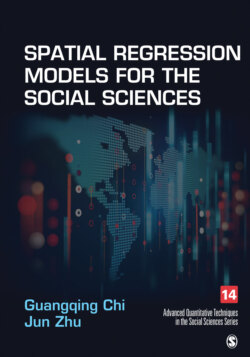Читать книгу Spatial Regression Models for the Social Sciences - Jun Zhu - Страница 16
1.3 Introduction to the Data Example
ОглавлениеAs we addressed in the Preface, the goal of this book is to help social scientists learn practical and useful statistical methods for spatial regression with relative ease. Our approach is to use concrete social data examples and in-depth analyses to illustrate the statistical concepts, models, and methods while keeping the use of statistical formulas and proofs at a minimum. No background of mathematical statistics is assumed of readers.
For ease of presentation, for most methods discussed in this book, we focus on one case study with one primary data example for addressing specific research questions rather than different studies with different data sets, variables, and/or research questions. Readers are encouraged to think about how their own data could be analyzed to address their research questions while reading our data analyses.
The data example used throughout this book is a possible template for readers to consider how their own data can be analyzed to address their research questions.
In the primary data example for this book, the state of Wisconsin in the United States is the study area of interest. We illustrate the use of spatial regression models and methods by studying population change as the response variable in relation to a variety of factors spatially and temporally at the minor civil division (MCD) level. In this book, population change is specifically referred to as a change in population size; that is, the outcome could be either population growth or population decline. Population change is a familiar subject to most social scientists and has been considered an essential component in many social science disciplines, making this data example quite accessible to many social scientists.
In the following subsections, we first review why and how population change is seen as a spatial phenomenon in several social science disciplines. There are two purposes for doing this. One, population change is the primary data example used throughout this book for demonstrating the use of spatial regression models, and thus it deserves a thorough understanding on its spatial dimension to build the theoretical foundation for spatially analyzing population change. Two, many social science phenomena are studied in multiple social science disciplines with different approaches; researchers often review and adopt approaches from other disciplines. Our review of population change as a spatial phenomenon (or spatial process) can serve as a template for studying the spatial effects of other social phenomena. We then briefly introduce the state of Wisconsin to readers who are not familiar with it and follow with a description of the MCD, which is the spatial unit of analysis. Finally, we present descriptive statistics of population change in Wisconsin.
